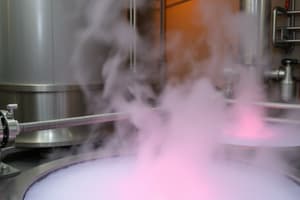Podcast
Questions and Answers
What condition must the ratio of lattice pitch to rod diameter meet for the correlation of liquid metal through a hexagonal lattice to be valid?
What condition must the ratio of lattice pitch to rod diameter meet for the correlation of liquid metal through a hexagonal lattice to be valid?
- s/d > 2.00
- s/d > 1.35 (correct)
- s/d > 1.10
- s/d > 0.85
Which physical property's value does NOT affect the calculation of heat transfer coefficients in turbulent flow according to the Dittus-Boelter equation?
Which physical property's value does NOT affect the calculation of heat transfer coefficients in turbulent flow according to the Dittus-Boelter equation?
- Density ( ρ ) (correct)
- Specific heat capacity ( cp )
- Thermal conductivity ( k )
- Viscosity ( μ )
According to Newton’s law of cooling, what does the variable Tc represent?
According to Newton’s law of cooling, what does the variable Tc represent?
- The ambient temperature
- The temperature of the coolant
- The temperature of the object being cooled (correct)
- The maximum allowable temperature
In the provided thermal resistance analysis, which term represents the conductive resistance across a cylindrical shell?
In the provided thermal resistance analysis, which term represents the conductive resistance across a cylindrical shell?
Which of the following is true about the Peclet number Pe?
Which of the following is true about the Peclet number Pe?
What does the variable q' represent in Newton's law of cooling equation?
What does the variable q' represent in Newton's law of cooling equation?
Which dimensionless number is used to characterize the flow regime and influence heat transfer coefficients?
Which dimensionless number is used to characterize the flow regime and influence heat transfer coefficients?
What does the term 'thermal resistance' represent in the context of heat transfer?
What does the term 'thermal resistance' represent in the context of heat transfer?
When considering heat transfer in reactors, which factor is essential for achieving efficient convection?
When considering heat transfer in reactors, which factor is essential for achieving efficient convection?
What primarily dictates heat removal by conduction in a laminar flow scenario?
What primarily dictates heat removal by conduction in a laminar flow scenario?
Which condition indicates turbulent flow according to the Reynolds number?
Which condition indicates turbulent flow according to the Reynolds number?
Which equation is typically used to determine the heat transfer coefficient under turbulent flow conditions?
Which equation is typically used to determine the heat transfer coefficient under turbulent flow conditions?
What is the result of lowering thermal resistance in a system?
What is the result of lowering thermal resistance in a system?
What does an increase in Reynolds number typically result in regarding heat transfer?
What does an increase in Reynolds number typically result in regarding heat transfer?
Which factor is a limitation of the established heat transfer coefficient equations?
Which factor is a limitation of the established heat transfer coefficient equations?
What characterizes heat transfer by convection in a system?
What characterizes heat transfer by convection in a system?
What does Fourier's law describe in the context of heat transfer?
What does Fourier's law describe in the context of heat transfer?
According to Newton's law of cooling, how is heat transfer quantified?
According to Newton's law of cooling, how is heat transfer quantified?
In thermal resistance analysis, what does the thermal resistance of a material depend on?
In thermal resistance analysis, what does the thermal resistance of a material depend on?
What does the heat transfer coefficient indicate in a nuclear reactor's convection process?
What does the heat transfer coefficient indicate in a nuclear reactor's convection process?
Which expression represents Newton's law of cooling?
Which expression represents Newton's law of cooling?
What is the primary factor that affects heat transfer coefficients in reactors?
What is the primary factor that affects heat transfer coefficients in reactors?
In relation to heat conduction, what does steady-state mean?
In relation to heat conduction, what does steady-state mean?
What does a higher value of the heat transfer coefficient signify?
What does a higher value of the heat transfer coefficient signify?
What does the equation $q = m c (T - T_0)$ represent?
What does the equation $q = m c (T - T_0)$ represent?
Flashcards are hidden until you start studying
Study Notes
Heat Transfer Coefficients in Nuclear Reactors
- Heat removal by coolant can occur through conduction and convection.
- Conduction dominates in laminar flow where fluid moves parallel to the channel with no radial movement.
- Convection dominates in turbulent flow with significant velocity fluctuations in the radial direction, carrying heat from the wall to the bulk of the liquid.
- Nuclear power plants utilize forced convection, creating a turbulent flow with a more uniform bulk temperature and causing a rapid temperature drop near the fuel.
Reynolds Number
- This dimensionless parameter characterizes fluid flow, relating fluid velocity, density, and viscosity to channel size.
- The Reynolds number is calculated with the formula: Re = (De * u * p) / u, where De is the equivalent diameter of the channel, u is the velocity, p is the density, and u is the viscosity.
- Turbulent flow, indicated by high Re values, leads to greater heat transfer to the coolant.
- The following conditions are used to classify flow:
- Laminar flow: Re < 2000
- Mixed flow: 2000 < Re < 10000
- Turbulent flow: Re > 10000
Heat Transfer Coefficients in Nuclear Reactors
- Heat transfer coefficients are determined experimentally and expressed as experimental correlations.
- The Nusselt number (Nu) is used to describe heat transfer effectiveness, with Nu = (h*De)/k, where h is the heat transfer coefficient, De is the equivalent diameter, and k is the thermal conductivity.
- The Prandtl number (Pr) is used to describe the relative importance of momentum and thermal diffusion in fluid flow, with Pr = (cp*u)/k, where cp is the specific heat, u is the viscosity, and k is the thermal conductivity.
- For turbulent flow in a long straight channel, the Nusselt number can be calculated using the Dittus-Boelter equation: Nu = C * Re^m * Pr^n, where C, m, and n are constants based on the specific fluid and flow conditions.
- The Dittus-Boelter equation has limitations:
- Only valid for reference temperatures.
- Not applicable when conduction becomes significant.
- Large errors can occur if the channel deviates significantly from a circular shape.
- Liquid metal coolants, such as sodium, have high thermal conductivities, resulting in less steep temperature gradients in the coolant.
- A specific correlation is available for liquid metal coolants through a hexagonal lattice of rods: Nu = 0.66 + 3.126*(s/d) + 1.184*(s/d)^2 + 0.0155*(Pe)^0.86, where s/d is the ratio of lattice pitch to rod diameter, and Pe is the Peclet number.
- The Peclet number, Pe, is calculated as Pe = Re * Pr.
Newton's Law of Cooling
- Newton's law of cooling describes the heat transfer from a heated solid to a moving fluid, with the formula: q" = h * (Tc - Tb), where q" is the heat flux, h is the heat transfer coefficient, Tc is the surface temperature, and Tb is the bulk temperature of the fluid.
- Heat transfer coefficients typically vary based on the fluid, flow type, coolant temperature, etc.
Total Thermal Resistance
- The total thermal resistance in a system can be calculated as the sum of the resistances associated with each component.
- For a plate-type fuel element, the total resistance is R = (a/2kA) + (b/kcA) + (1/h*A), where k is the thermal conductivity, a and b are thicknesses, and A is the area.
- For a clad cylindrical fuel element, the total resistance is R = (1/4pikfH) + (ln(1+b/a)/2pikcH) + (1/h*A), where kf is the fuel conductivity, kc is the cladding conductivity, a and b are radii, and H is the height.
- For a space-dependent heat source, the heat transfer rate can be calculated for specific points along the channel using the formula: q(z) = (T(z)-Tb(z))/R, where T(z) and Tb(z) are the temperatures at position z, and R is the total resistance.
Temperature along the Coolant Channel
- The coolant channel is a volume associated with a single fuel rod where heat generated within the fuel transfers to the channel.
- As heat is added, the coolant temperature increases, causing a temperature rise along the coolant channel.
- The temperature change in a specific section of coolant can be calculated as dTb = (q" * Af * dz)/(w * cp), where q" is the heat flux, Af is the fuel surface area, dz is the length of the coolant section, w is the coolant flow rate, and cp is the specific heat of the coolant.
- For a fuel rod at the center of the channel, the heat flux is calculated as q'" = qmax * cos(pi * z / H), where qmax is the maximum heat generation rate, z is the position along the channel, and H is the channel length.
- The maximum bulk temperature of the coolant in the channel is calculated as: Tb = Tb0 + (qmax * Af / w * cp * pi) * [1 + sin(pi * z / H)] / [cos(pi * z / H)], where Tb0 is the initial coolant temperature, qmax is the maximum heat generation rate, Af is the fuel surface area, w is the coolant flow rate, cp is the specific heat of the coolant, z is the position along the channel, and H is the channel length.
- The temperature difference between the mean coolant temperature (Tm) and bulk temperature (Tb) can be calculated as: Tm - Tb = R * qmax * cos(pi * z / H) / H, where R is the total thermal resistance, qmax is the maximum heat generation rate, z is the position along the channel, and H is the channel length.
- The maximum coolant temperature (Tb) along the channel can be calculated as: Tb = Tb0 + (qmax / pi * w * cp) * [1 + sin(pi * z / H)] / [cos(pi * z / H)], where Tb0 is the initial coolant temperature, qmax is the maximum heat generation rate, w is the coolant flow rate, cp is the specific heat of the coolant, z is the position along the channel, and H is the channel length.
- The temperature difference between the surface temperature (Tc) and bulk temperature (Tb) is calculated as: Tc - Tb = Rh * qmax * cos(pi * z / H) / H, where Rh is the thermal resistance of the coolant, qmax is the maximum heat generation rate, z is the position along the channel, and H is the channel length.
Studying That Suits You
Use AI to generate personalized quizzes and flashcards to suit your learning preferences.




